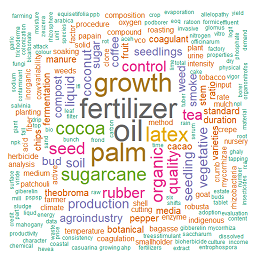Analisis Pertumbuhan dan Produktivitas Kelapa Sawit pada Variasi Kerapatan Tanam
DOI:
https://doi.org/10.25181/jaip.v12i2.3535Keywords:
average bunch weight, planting density, productivity, sex ratio, shade avoidanceAbstract
In oil palm growth, planting density has a sustainable impact on its productivity. To enhance the long-term growth and production yield of oil palm, it is crucial to consider the establishment of appropriate planting densities during the initial planting phase. This research explores the relationship between planting density and productivity, highlighting the importance of determining optimal plant densities for optimal yields. The study was conducted at the Muara Tawang Estate (MTNE) in Kapuas Hulu Regency, West Kalimantan Province. Two blocks of oil palm land with three different planting densities (130, 136, and 143 plants per hectare) were observed to understand the relationship between planting density and agronomic characteristics. Measurements were taken on plant height, frond length, petiole width, number of male and female flowers, and sex ratio. The analysis unveiled consistent trends in oil palm production, which varied based on planting density. Planting densities of 130 and 136 showed superior production trends compared to 143, with 136 demonstrating production increases ranging from 19.8% to 29.8% relative to density 143, alongside enhancements in plant height and frond length by 4.6% and 5.4%, respectively. Additionally, petiole thickness and width were notably lower in density 143, experiencing reductions of 8.0% and 11.0%, respectively, compared to density 136, while the sex ratio exhibited a similar pattern, declining by 34.0% in density 143 compared to 136. This highlights the importance of determining appropriate planting densities to enhance oil palm productivity.Downloads
References
Astuti, N. S., Karim, I., Nurlaela, Abdullah, M. A., & Dahniar. (2020). Contribution of oil palm (Elaeis guineensis J.) plantations to farmers’ income in West Sulawesi. Anjoro: International Journal of Agriculture and Business, 1(2), 45–51. https://doi.org/10.31605/anjoro.v1i2.892
Bisht, A. S., Bhatnagar, A., Pal, M., & Singh, V. (2012). Growth dynamics, productivity and economics of quality protein maize (Zea mays L.) under varying plant density and nutrient management practices. Madras Agricultural Journal, 99, 73–76.
Bonneau, X., & Impens, R. (2022). Experimental determination of the optimum oil palm planting density in Western Africa. OCL. https://doi.org/10.1051/ocl/2022019
Breure, C. J. (1988a). The Effect of Different Planting Densities on Yield Trends in Oil Palm. Experimental Agriculture, 24, 37–52. https://doi.org/10.1017/S0014479700015684
Breure, C. J. (1988b). The Effect of Palm Age and Planting Density on the Partitioning of Assimilates in Oil Palm (Elaeis guineensis). Experimental Agriculture, 24, 53–66. https://doi.org/10.1017/S0014479700015696
Chang, Y. Y., Abd Wahid, S. A., & Sim, C. C. (2022). Nitrogen and potassium fertiliser requirement optimisation for high-density planting in Oil palm (Elaeis guineensis) under Coastal environment of Peninsula Malaysia. International Journal of Agricultural Technology, 18(5), 1937–1948.
Djaingsastro, A. J., Manurung, S., & Simbolon, A. O. (2021). Evaluasi Perkembangan Vegetatif Pada Tanaman Kelapa Sawit Dengan Dua Pola Tanam. BEST Journal (Biology Education, Sains and Technology), 4(1), Article 1. https://doi.org/10.30743/best.v4i1.3942
Fauzi, Y., Widyastuti, Y. E., Satyawibawa, I., & Paeru, R. H. (2012). Kelapa Sawit. Penebar Swadaya Grup.
Gerritsma, W., & Soebagyo, F. X. (1999). An analysis of the growth of leaf area of oil palms in Indonesia. Experimental Agriculture, 35, 293–308. https://doi.org/10.1017/S0014479799003038
Hayata, H., Nursanti, I., & Kriswibowo, P. (2020). Pengaruh Jarak Tanam Yang Berbeda Terhadap Pertumbuhan Dan Produksi Kelapa Sawit (Elaeis guineensis Jacq). Jurnal Media Pertanian, 5(1), Article 1. https://doi.org/10.33087/jagro.v5i1.92
Huber, M., Nieuwendijk, N. M., Pantazopoulou, C., & Pierik, R. (2020). Light signalling shapes plant–plant interactions in dense canopies. Plant, Cell & Environment, 44, 1014–1029. https://doi.org/10.1111/pce.13912
Koh, L. P., & Wilcove, D. (2008). Is oil palm agriculture really destroying tropical biodiversity? Conservation Letters, 1. https://doi.org/10.1111/j.1755-263X.2008.00011.x
Limaho, H., Pramono, R., & Christiawan, R. (2022). Collaboration between Government and Palm Oil Industry to Achieve Sustainability Development Goals in Indonesia. Mulawarman Law Review. https://doi.org/10.30872/mulrev.v7i1.757
Pahan, I. (2021). Panduan Budidaya Kelapa Sawit untuk Pekebun. Penebar Swadaya.
Postma, J., Hecht, V. L., Hikosaka, K., Nord, E., Pons, T., & Poorter, H. (2020). Dividing the pie: A quantitative review on plant density responses. Plant, Cell & Environment. https://doi.org/10.1111/pce.13968
Rafii, M. Y., Isa, Z., Kushairi, A., Saleh, G., & Latif, M. (2013). Variation in yield components and vegetative traits in Malaysian oil palm (Elaeis guineensis Jacq.) dura × pisifera hybrids under various planting densities. Industrial Crops and Products, 46, 147–157. https://doi.org/10.1016/J.INDCROP.2012.12.054
Roig-Villanova, I., & Martínez-García, J. F. (2016). Plant Responses to Vegetation Proximity: A Whole Life Avoiding Shade. Frontiers in Plant Science, 7. https://doi.org/10.3389/fpls.2016.00236
Romero, H., Guataquira, S., & Forero, D. C. (2022). Light Interception, Photosynthetic Performance, and Yield of Oil Palm Interspecific OxG Hybrid (Elaeis oleifera (Kunth) Cortés x Elaeis guineensis Jacq.) under Three Planting Densities. Plants, 11. https://doi.org/10.3390/plants11091166
Sastrosayono, S. (2003). Budi Daya Kelapa Sawit. AgroMedia.
Suwarno, W. (2019). Kebijakan Sawit Uni Eropa dan Tantangan bagi Diplomasi Ekonomi Indonesia. Jurnal Hubungan Internasional, 8(1). https://doi.org/10.18196/hi.81150
Sylvia, N., Rinaldi, W., Muslim, A., Husin, H., & Yunardi. (2022). Challenges and possibilities of implementing sustainable palm oil industry in Indonesia. IOP Conference Series: Earth and Environmental Science, 969. https://doi.org/10.1088/1755-1315/969/1/012011
Windiastuti, E., Suprihatin, Bindar, Y., & Hasanudin, U. (2022). Identification of potential application of oil palm empty fruit bunches (EFB): A review. IOP Conference Series: Earth and Environmental Science, 1063. https://doi.org/10.1088/1755-1315/1063/1/012024
Downloads
Published
How to Cite
Issue
Section
License
Copyright (c) 2024 Wiwin Dyah Ully Parwati, Filemon Hepron Nadeak , Valensi Kautsar

This work is licensed under a Creative Commons Attribution-ShareAlike 4.0 International License.
Authors who publish with Jurnal Agro Industri Perkebunan agree to the following terms:
Authors retain copyright and grant the Jurnal Agro Industri Perkebunan right of first publication with the work simultaneously licensed under a Creative Commons Attribution License (CC BY-SA 4.0) that allows others to share (copy and redistribute the material in any medium or format) and adapt (remix, transform, and build upon the material for any purpose, even commercially) with an acknowledgment of the work's authorship and initial publication in Jurnal Agro Industri Perkebunan.
Authors are able to enter into separate, additional contractual arrangements for the non-exclusive distribution of the journal's published version of the work (e.g., post it to an institutional repository or publish it in a book), with an acknowledgment of its initial publication in Jurnal Agro Industri Perkebunan. Authors are permitted and encouraged to post their work online (e.g., in institutional repositories or on their website) prior to and during the submission process, as it can lead to productive exchanges, as well as earlier and greater citation of published work.


























